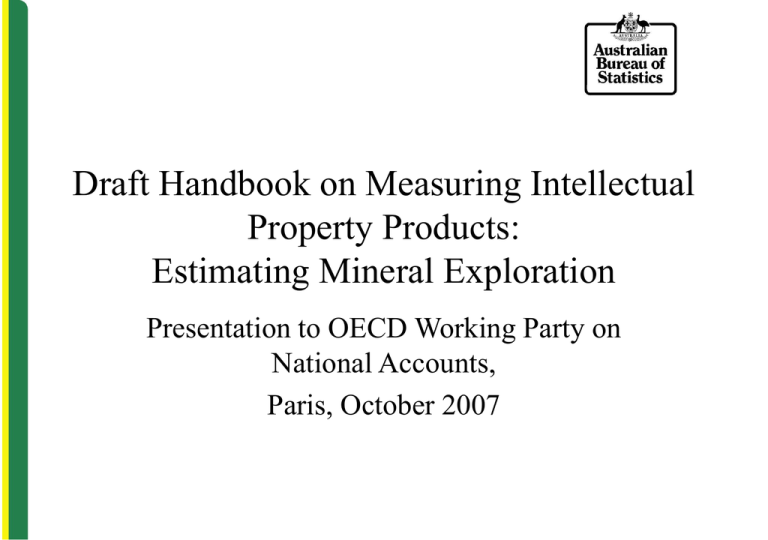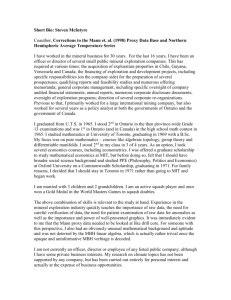Draft Handbook on Measuring Intellectual Property Products: Estimating Mineral Exploration
advertisement

Draft Handbook on Measuring Intellectual Property Products: Estimating Mineral Exploration Presentation to OECD Working Party on National Accounts, Paris, October 2007 Outline • • • • Developments in International standards Proposals for SNA93 Rev 1 Coverage of mineral exploration and evaluation Aspects of measurement – – – – Valuation Price and volume measures Depreciation and capital services Ownership and balance sheets • ABS sources and methods • Measurement issues International standards • SNA68 – Mineral exploration treated as intermediate consumption • SNA93 – Expenditure on mineral exploration capitalised – Addition to stock of knowledge and costs realise their benefits over an extended period of time • SEEA 2003 – Consistent with SNA93 with additional discussion on accounting treatment International standards (cont) • International accounting standards – IASB interim guideline – IFRS 6 – released in 2004 – Case by case assessment allowing capitalisation and expensing – A cost model is used when first recognised – Revaluation possible but guideline does not cover treatment of the asset once feasibility of extraction is demonstrated – IASB working group formed to examine issues further – Discussion paper scheduled for release in 2008 Proposals for SNA93 Rev 1 • Five proposed clarifications / refinements – Use of term “mineral exploration and evaluation” – Continue separation between mineral exploration as produced asset and sub-soil assets as non-produced – Clarify that when specialised firms provide services the actual output of these firms is used in valuing GFCF – The resource rent used to value sub-soil assets should be adjusted for the capital services provided by mineral exploration – Payment by extractor to owner treated as rent Coverage • Recommend use of IASB criteria – Consider the extent to which the expenditure is associated with finding specific mineral resources – Possible expenditures include • • • • Acquisition of rights to explore (incl. leases & licences) Topographical, geological studies, etc Drilling, trenching, sampling Evaluation of technical and commercial viability Valuation • Much mineral exploration is done on an own account basis and so should be valued at the sum of costs • SNA93 Rev 1 has details. Relevant costs include: – – – – – Intermediate consumption Compensation of employees COFC Return to fixed capital Taxes less subsidies on production Price and volume measures • Preference for output price index – Technically feasible but resource intensive to develop and maintain • Likely use of an input price index based on deflating the various costs of production – Will miss productivity gains that are likely to have been significant – Some adjustment for productivity might be sensible Depreciation & capital services • Use a conventional approach through assumptions regarding age-price and age efficiency functions • Asset life linked to life of the sub-soil asset discovered • Need to consider appropriate choices of age-price and age efficiency functions Ownership & Balance sheets • Ownership of mineral exploration rests with the unit undertaking the exploration • However, in many countries ownership of the subsoil assets rests with the government – Results of mineral exploration may become freely available • Balance sheets should record the mineral exploration and sub-soil assets separately Ownership & Balance sheets • “Double counting” – Is the value of mineral exploration included in the value of the stock of sub-soil assets? – Provided costs of mineral exploration deducted in estimating resource rent there is no problem • Allocating ownership – If governments own sub-soil assets then the accounts for the extractor will include the mineral exploration asset but exclude the sub-soil asset – Analysis less obvious if conducted with respect to mining activity – Ongoing area for investigation and research ABS source & methods • Quarterly surveys of firms in mineral and petroleum exploration – Exploration expenditure allocated between current and capital in line with Australian and international accounting standard • Deflation using input price index – Largest component wage rates (77%) • Derive depreciation and related capital estimates through PIM • In balance sheets currently include mineral exploration with sub-soil assets Measurement issues • Volatility of series impacting on editing data and weighting series • Finding suitable deflators – Appreciate any general advice that the manual can give in this area • Defining units appropriately especially given own account nature of the work Conceptual issues • Rationale for inclusion of unsuccessful exploration – See draft HMIP paragraphs 19-20 • Rationale for treatment of “freely available” mineral exploration knowledge – Suggest that since only one extractor can use the information at one time then there is no public benefit even if knowledge is freely available – Thus the boundary considerations that apply to R&D expenditures do not apply for mineral exploration
